Short range radio
Description
Live data is essential in competitions for delivering information to organisers or speakers. It enhances the overall experience for spectators and competitors. For spectators, it is far less spectacular to watch an event like orienteering, MTB Enduro, trail, and so on, by having only the final results. The competitors in the forest or on the track might at some stage pass by the competition arena, but most of the time they are invisible for the spectators.
With the use of additional SPORTident devices (data transmitter and data receivers), live data can be produced to provide more information for the speaker and the public, like the position in the race of the participants, allowing them to make race predictions and to analyse the respective split times.
The radio data transmission between the SPORTident devices is done using a proprietary protocol and with a short range.
The collected data can be processed by a web service or used directly by evaluation software (see section Live data).
The following SPORTident devices provide radio transmission via SRR (short range radio):
- Data transmitters
- BSF8-SRR
- SIAC
- Data receivers
- SRR USB Dongle (connects to a PC)
- SI-GSM Modem
The following sections describe the devices and their configuration in detail.
Transmitter devices
BSF8-SRR
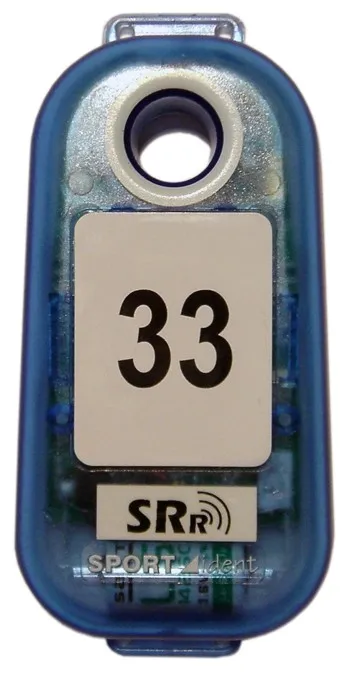
This special SI-Station is a BSF8-DB additionally equipped with inbuilt radio to deliver timing data to a receiver.
The data from a direct punch with a SI-Card is transmitted from the SI-Station to a receiver.
BSF8-SRR configuration by using Config+
- Read the station in remote mode by clicking on [Settings].
- The following advanced settings have to be set:
- Enable [Auto send]
- Disable [Legacy protocol]
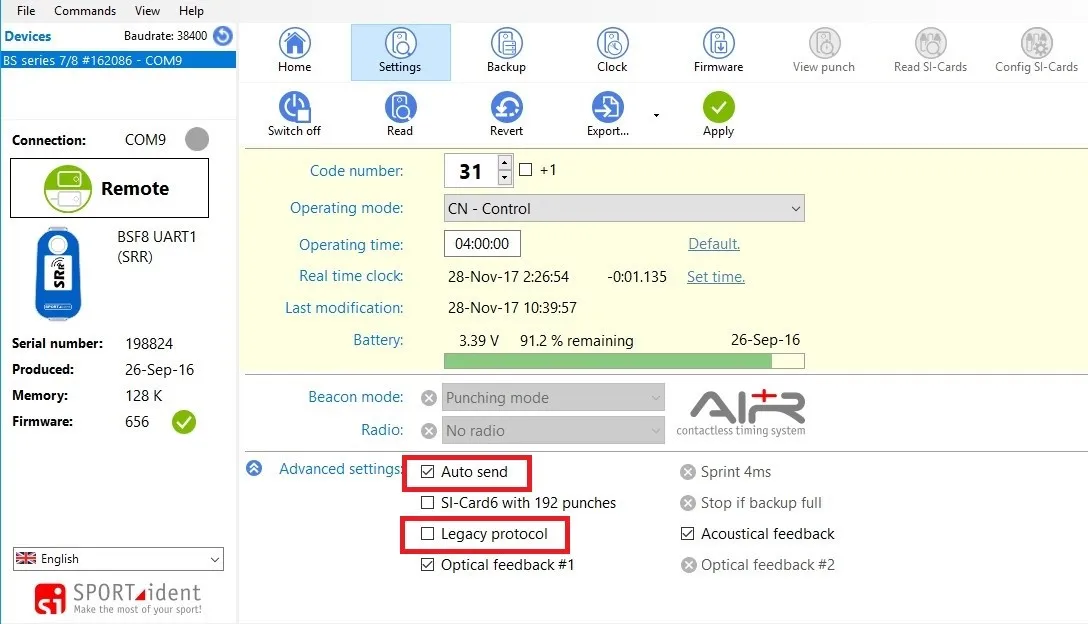
SIAC
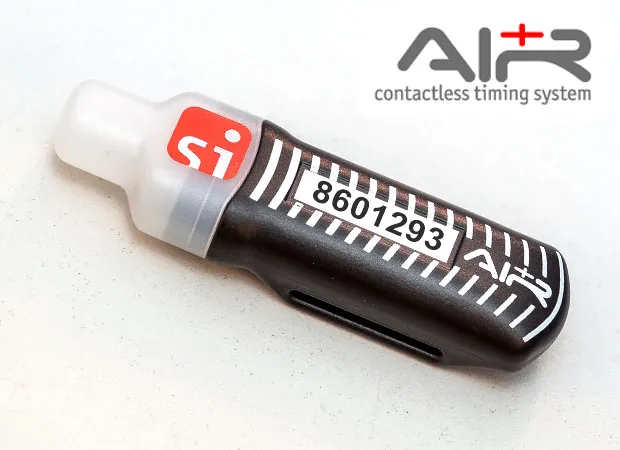
The SIAC features an inbuilt radio to send timing data to a receiver.
The SIAC only sends its data to a receiver by radio when
- it is active,
- it punches a station in AIR+ mode and
- is requested by the station to send its data.
The SIAC is activated by punching it into a BS7/8/9 that is in CHECK (SIAC must be cleared), SIAC ON or SIAC Test operating mode.
The SI-Stations BS7/8/9 and BS11 are set to AIR+ mode by selecting one of the beacon operating modes.
The radio request is set at the station via Config+ [Radio] property.
Configuring the radio option of a station in Config+
- Read the station by clicking on [Settings].
- Click on the field of the operating mode (below the control number). The different options are shown. Choose the desired beacon function.
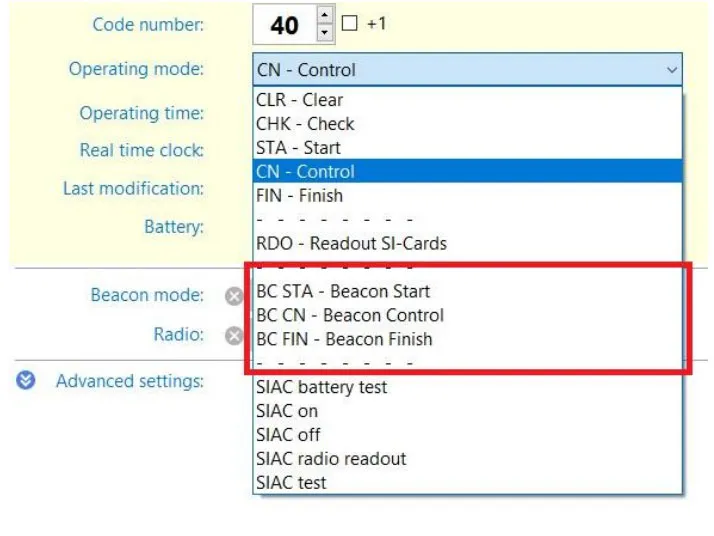
- Four different SIAC radio options can be chosen in the AIR+ settings area:
- No radio: This is the default setting. It should only be changed if radios will be used during the event to avoid unnecessary consumption of battery power of the SIAC.
- Send last record: Transmits the most recently received record. This is normally, the ‘punching’ of the control where the radio is mounted.
- Send all unsent records: Transmits all the records not yet successfully transmitted.
- Send all card contents: Transmit all the records stored in the SIAC’s memory.
Receiver devices
SRR USB Dongle
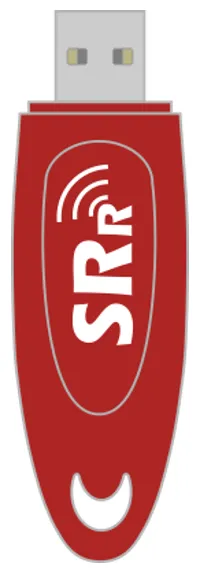
The SRR USB Dongle receives data records sent by a BSF8-SRR or a SIAC. The device features a USB interface for easy connection with a PC, laptop or other standard communication equipment.
The SRR USB Dongle can only receive data on one of the two possible radio channels at a time.
Configuring the radio channel of the SRR USB Dongle in Config+
- Plug the SRR USB Dongle in a USB port of the computer and click on [Settings].
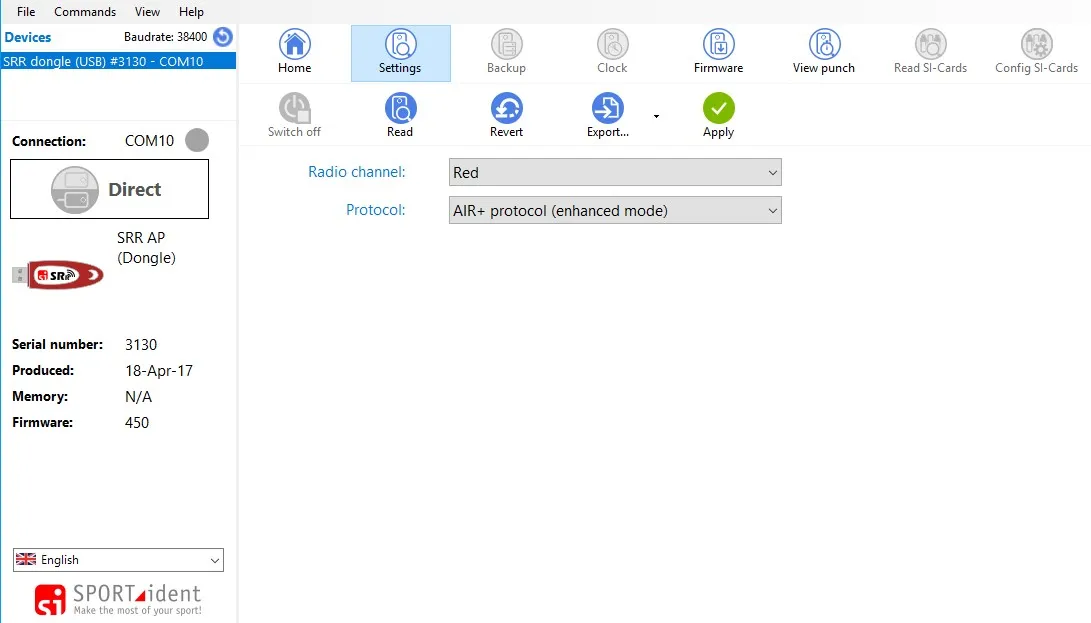
- Choose the [Radio Channel] for the dongle. If you only use a single dongle, there is no preferred channel, both are identical from the technical point of view. It is recommended using two dongles, one working on the ‘red’ and the second on the ‘blue’ radio channel to avoid occasional loss of information.

- The default setting for the communication [Protocol] is the AIR+ protocol. Unless an older evaluation software is used, this setting should not be changed.

SI-GSM

The SI-GSM Modem features two built-in SRR receiver modules. One for each of the possible radio channels (red and blue). It features a data transmission to a web service by using the mobile network. No SRR-specific configuration is needed.
The SI-GSM Modem is delivered ready to use by SPORTident. This means that a SIM card is already mounted inside of the box. The SIM card offers a general service and automatically selects the best signal provider. Each SI-GSM has its unique identification number. This is important as it will be used to identify the device that is sending data to the monitoring or evaluation software.
As the SI-GSM is delivered with an active SIM card, costs for the use of the device will be based on the number of runners per event and day.
Please contact support@sportident.com for more information.
The SI-GSM is turned on by holding the SPORTident instruction card on/off switch against the I/O label until the LCD screen becomes active. To turn it off, the switch needs to be kept against the I/O label for about 4 seconds. A blinking orange LED confirms the turning off procedure until the LCD display is empty.
The SI-GSM has a rechargeable battery and needs to be charged before application. Therefore, the stations are equipped with a standard mini USB connector. The stations need to be connected directly to a USB port of the computer or with an adapter to the socket. To assure the waterproofness of the stations, the mini USB connectors are protected and you should ensure to always put the protector back on after charging.
See section LCD display information / SI-GSM for display information explanation.
Reading the SI-GSM in Config+
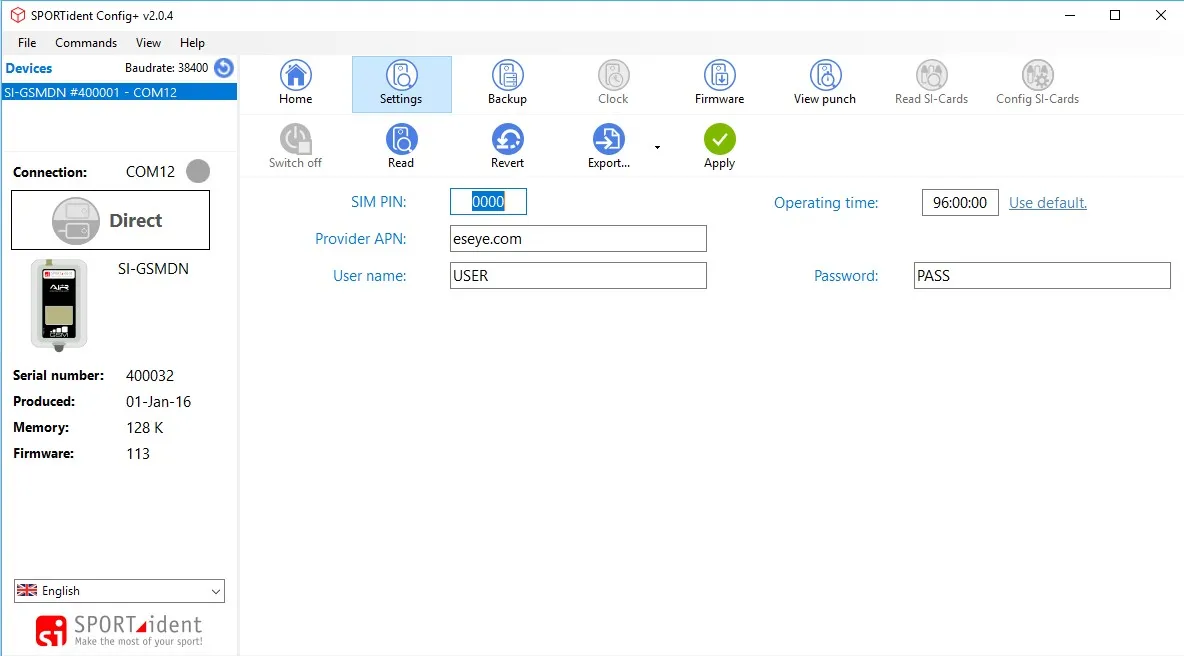
The settings of the SI-GSM can be read in Config+ by selecting the device and clicking on [Settings]. The settings are visible but cannot be modified. The SI-GSM is delivered preconfigured and any changes would only disturb the correct operation of the device. The default operating time is 96 hours, which is identical to the capacity of the battery. In a normal use case the device should be manually switched off. The buttons [Backup] and [View punch] will provide the needed information in the same way as any other SI device.
Technical background
The SPORTident Short Range Radio (SI-SRR) enables wireless transmission of SPORTident data records over distances of up to 8 metres. The radio is working in the licence free 2.4 GHz radio band and can be used worldwide.
SI-SRR uses two radio channels (named ‘red’ and ‘blue’) to achieve a robust data transmission with a low error rate. The BSF8-SRR station, the SIAC and the SI-GSM Modem can transmit or receive on both radio channels. The SRR USB Dongle can only receive on one radio channel. This can be configured.
A data receiver device such as the SRR USB Dongle or the SI-GSM Modem can manage up to eight logical radio links. However, there can be any possible numbers of data transmitter devices such as stations BSF8-SRR or SIACs in the service area.
Practical use
Radio transmission must be activated in the transmitters and receivers. This is possible via the configuration using Config+. For a detailed description, see the sections on the devices above.
The power consumption of the BSF8-SRR station and also of the SIAC increases significantly when they transmit data by radio. Therefore, only activate the radio when you really use it. Make sure that the sender also has the possibility to transmit its data to a receiver. Otherwise, the transmitter will repeatedly try in vain to transmit its data and consume energy in the process.
The receiver must be placed as close as possible to the transmitter. The maximum transmission range between a non-moving transmitter and receiver is approx. 8 metres. At the checkpoint (orienteering) the receiver can be mounted at the same post as the SI-Station (BSF8-SRR Station or a SI-Station in beacon mode with active radio).
If participants pass a checkpoint at high speed and in a given direction, the receiver should be placed approx. 6 metres in the direction of passing behind the checkpoint. For example, in a MTB competition, the receiver (modem) is placed 6 metres behind the checkpoint (intermediate or finish time) in the direction of riding.
Sufficient distance (at least 30 metres) must be allowed between two receivers to avoid collisions and loss of data. If two SRR USB Dongles are in close proximity, both should receive on different radio channels. We recommend the simultaneous use of two SRR USB Dongles, one on the radio channel ‘red’, the other on ‘blue’, to improve data transmission.
Try to reduce the number of records a SIAC has to transmit at once. This reduces its energy consumption and increases the transmission quality. If you want to use the send all unsent records setting, place receivers at several checkpoints and have them transmit a few records at a time. For example, at an MTB Enduro competition, the SIAC should transmit records at the finish timekeeping of each stage. It then only has to transmit two records, one for the start time and one for the finish time.
If a BSF8-SRR station is configured as a beacon control, the radio is activated and is now punched by a SIAC in the contactless way, the SIAC transmit their data to the receiver. In this case, the data is not transmitted via the station’s radio module.
At this station, an SI-Card can be punched directly and an SIAC indirectly at the same time. Both SI cards store their stamps. There may be conflicts in the radio transmission and only one of the two stamps may be successfully transmitted to the receiver, as the station and the SIAC are now sending data simultaneously.
When using an SI-GSM Modem at locations with poor network coverage, the modem can only transmit the data to the web service and the evaluation software with a delay or not at all if the connection is interrupted.
Monitor received data in Config+
Config+ features a monitor function to visualize the SRR functionality.
- Plug a SRR USB Dongle or a SI-GSM in a USB port of your computer. If you are using an SI-GSM, switch it on.
- Select the device in the device list and click the feature [View punch] in the main toolbar.
- Now create stamps by punching directly or contactless with your SI card. The window immediately displays the data that the connected device receives from your BSF8-SRR station or your SIAC. The available information is slightly different between a classic and an AIR+ punch.
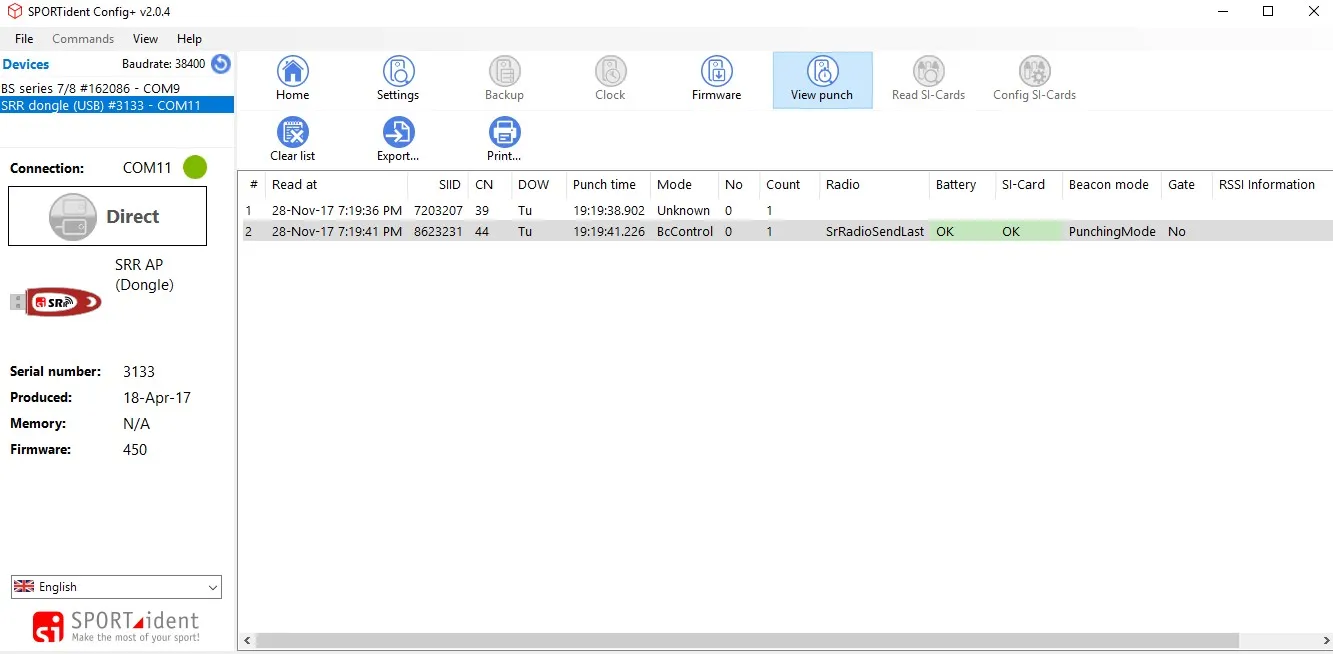
The first row shows the information for a classic punch, the second one for a SIAC. Here, additional information is given about the configuration of the station that gave instructions to the SIAC (in this example Beacon Control 44 – radio Send last record – punching mode – No gate). It also displays information about the SIAC (for example Battery OK).